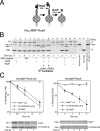A pair of circularly permutated PDZ domains control RseP, the S2P family intramembrane protease of Escherichia coli
- PMID: 18945679
- PMCID: PMC3259892
- DOI: 10.1074/jbc.M806603200
A pair of circularly permutated PDZ domains control RseP, the S2P family intramembrane protease of Escherichia coli
Abstract
The sigma(E) pathway of extracytoplasmic stress responses in Escherichia coli is activated through sequential cleavages of the anti-sigma(E) protein, RseA, by membrane proteases DegS and RseP. Without the first cleavage by DegS, RseP is unable to cleave full-length RseA. We previously showed that a PDZ-like domain in the RseP periplasmic region is essential for this negative regulation of RseP. We now isolated additional deregulated RseP mutants. Many of the mutations affected a periplasmic region that is N-terminal to the previously defined PDZ domain. We expressed these regions and determined their crystal structures. Consistent with a recent prediction, our results indicate that RseP has tandem, circularly permutated PDZ domains (PDZ-N and PDZ-C). Strikingly, almost all the strong mutations have been mapped around the ligand binding cleft region in PDZ-N. These results together with those of an in vitro reaction reproducing the two-step RseA cleavage suggest that the proteolytic function of RseP is controlled by ligand binding to PDZ-N.
Figures





Similar articles
-
PDZ domains of RseP are not essential for sequential cleavage of RseA or stress-induced σ(E) activation in vivo.Mol Microbiol. 2012 Dec;86(5):1232-45. doi: 10.1111/mmi.12053. Epub 2012 Oct 15. Mol Microbiol. 2012. PMID: 23016873
-
A structure-based model of substrate discrimination by a noncanonical PDZ tandem in the intramembrane-cleaving protease RseP.Structure. 2014 Feb 4;22(2):326-36. doi: 10.1016/j.str.2013.12.003. Epub 2014 Jan 2. Structure. 2014. PMID: 24389025
-
Cleavage of RseA by RseP requires a carboxyl-terminal hydrophobic amino acid following DegS cleavage.Proc Natl Acad Sci U S A. 2009 Sep 1;106(35):14837-42. doi: 10.1073/pnas.0903289106. Epub 2009 Aug 17. Proc Natl Acad Sci U S A. 2009. PMID: 19706448 Free PMC article.
-
Biochemical Characterization of Function and Structure of RseP, an Escherichia coli S2P Protease.Methods Enzymol. 2017;584:1-33. doi: 10.1016/bs.mie.2016.09.044. Epub 2016 Oct 31. Methods Enzymol. 2017. PMID: 28065260 Review.
-
Biochemical and structural insights into intramembrane metalloprotease mechanisms.Biochim Biophys Acta. 2013 Dec;1828(12):2873-85. doi: 10.1016/j.bbamem.2013.03.032. Biochim Biophys Acta. 2013. PMID: 24099006 Free PMC article. Review.
Cited by
-
Membrane proteases in the bacterial protein secretion and quality control pathway.Microbiol Mol Biol Rev. 2012 Jun;76(2):311-30. doi: 10.1128/MMBR.05019-11. Microbiol Mol Biol Rev. 2012. PMID: 22688815 Free PMC article. Review.
-
New insights into S2P signaling cascades: regulation, variation, and conservation.Protein Sci. 2010 Nov;19(11):2015-30. doi: 10.1002/pro.496. Protein Sci. 2010. PMID: 20836086 Free PMC article. Review.
-
Genome-wide analysis of PDZ domain binding reveals inherent functional overlap within the PDZ interaction network.PLoS One. 2011 Jan 24;6(1):e16047. doi: 10.1371/journal.pone.0016047. PLoS One. 2011. PMID: 21283644 Free PMC article.
-
The role of site-2-proteases in bacteria: a review on physiology, virulence, and therapeutic potential.Microlife. 2023 May 3;4:uqad025. doi: 10.1093/femsml/uqad025. eCollection 2023. Microlife. 2023. PMID: 37223736 Free PMC article. Review.
-
The Escherichia coli S2P intramembrane protease RseP regulates ferric citrate uptake by cleaving the sigma factor regulator FecR.J Biol Chem. 2021 Jan-Jun;296:100673. doi: 10.1016/j.jbc.2021.100673. Epub 2021 Apr 16. J Biol Chem. 2021. PMID: 33865858 Free PMC article.
References
-
- Raivio, T. L. (2005) Mol. Microbiol. 561119 -1128 - PubMed
-
- Rowley, G., Spector, M., Kormanec, J., and Roberts, M. (2006) Nat. Rev. Microbiol. 4 383-394 - PubMed
-
- Missiakas, D., Mayer, M. P., Lemaire, M., Georgopoulos, C., and Raina, S. (1997) Mol. Microbiol. 24 355-371 - PubMed
-
- De Las Peñas, A., Connolly, L., and Gross, C. A. (1997) Mol. Microbiol. 24 373-385 - PubMed
Publication types
MeSH terms
Substances
LinkOut - more resources
Full Text Sources
Molecular Biology Databases

